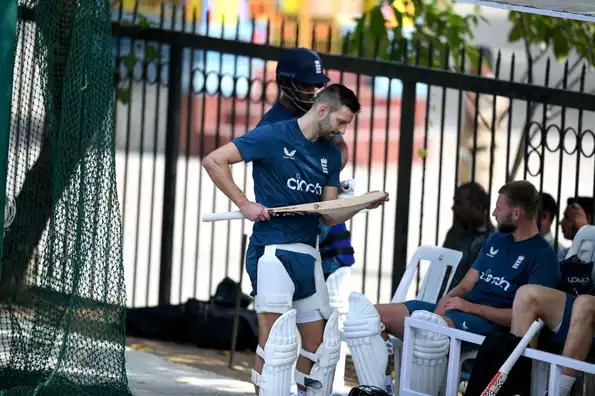
The international career of Mark Wood has been a turbulent one. In all formats, he is unquestionably a valuable asset for England when in peak physical condition. He demonstrated this during the previous year’s home Ashes series by using his speed to force the Australian batsmen to seek shelter. Despite ongoing injury concerns that have impeded his progress, the 34-year-old remains resilient. A fast bowler may face his or her greatest challenge during a five-match Test series in India, especially against opponents from outside the subcontinent. Wood, being the flamboyant individual that he is, not only appeared undeterred by the task at hand but also dispelled any concerns regarding his fitness.
“I’m ready to go,” said Wood at the press conference. “Like a lot of the boys, we’ve done a lot of preparation in Abu Dhabi, a lot of fitness in the winter months behind closed doors. So yeah I feel fit and ready to go.”
Given Wood’s reputation for genuine pace and being an enforcer, his role in a series expected to be spin-dominated is intriguing. With pitches unlikely to offer much pace and bounce, Wood’s main weapon could be reverse swing. The Durham pacer acknowledges the challenge but is enthusiastic about facing it.
Expressing excitement, Wood notes the different conditions in India compared to England. With the need to mix and match with four seamers, he anticipates shorter, sharper spells. While he acknowledges the challenge of not being the strike bowler, he embraces various roles, including employing bouncer tactics, reversing the ball, or supporting the spinner.
Reflecting on England’s high-flying approach in the 2023 home summer, Wood acknowledges the real test will be touring Australia for the Ashes. Contrasting the challenges of pace and bounce in Australia with the varied conditions in India, he emphasizes the need to break through India’s winning habit.
Regarding England’s aggressive ‘Bazball approach,’ Wood clarifies it’s not all-out aggression but a methodical strategy. He acknowledges the team’s willingness to adjust the tempo and emphasizes a balanced approach in both batting and bowling, expecting more of the same in the upcoming series.
“I don’t think it’ll be defensive,” the fast bowler said of England’s approach. “We’ll still look to take the game on and take the positive option. I think at times it’s being smart… for example if India are bowling well, that may be a chance to just ‘let’s consolidate and sit in’ and then when the chance comes to put the pressure back on, that’s when we put the pressure back on. It’s not just gung-ho all the time. It’s, I guess, soaking up that pressure when needed… might be when the Indian batsmen are on top, we’ve to soak up that pressure, try and create bit of a , I guess, theatre, drama and a bit of consistency on the field and when it’s time to attack again, attack full out. And that’s the same with both bat and ball.
“I think we assess conditions when you’re out there. Bouncer might be one that you bowl very rarely or maybe one that you bowl a lot. But I think I wouldn’t know that until I’ve bowled the first ball on the pitch, if I’m picked. When I bowl that bouncer, if the pitch is going to be two-paced, that sometimes can help. If it’s slow again that can help sometimes’ the batsman can be through with that. Someone like Rohit, I know how good he is on the short ball. But that doesn’t necessarily mean I won’t bowl a bouncer, it just means I have to be really accurate with it and bowl it at the right time.”
Conditions and pitches in particular have come in for endless debates across the globe. While spinning tracks in India have always spurred discussions in recent years, the pitches during the South Africa-India series and the Australia-Pakistan series also came under scrutiny. Particularly the Newlands encounter between South Africa and India – a game that became the shortest completed Test in the history of the game. While the importance of pitches has led to polarised opinions, Wood revealed that the English camp aren’t too bothered about such talks.
“We discuss the pitch but I wouldn’t say we discuss it at length or worry about it. We know again how good India are but we have enough self belief in our group that we can do something special. We got seamers, we got spinners, we got good batters and we got good history behind us in the recent past. We’ve won away from home and we’ve played some good, positive cricket. We know that this is a massive task but at the same time we have to have that self belief. It’s no good coming here and just rolling over and thinking the pitches will do the work. Or it’s going to be tough because the pitches are not what we’re used to. We have to find a way. That’ll be what we’ll try and do in the game. We’ll adapt. We have a captain that always wants to take the game forward, isn’t going to sit back. It should be a fun and intense series.”
India were dealt a big blow for the first two Tests with Virat Kohli opting out due to personal reasons. Given that India’s batting line-up in the longest format is on the cusp of transition, the 35-year-old’s absence does create a void for the hosts. When asked if the development was an advantage for England, Wood chose not to read too much into it.
“We look [at] them exactly the same [way]. They are quality, all through the batting line-up. Obviously he’s one of the best players ever. But you look right through the line-up, they’ve got quality players. The next guy who steps in is also a quality player. Like I mentioned before, we know the challenges here. India very rarely lose at home. I think it’s almost like a bit of a free hit for us, we can come in here and give it a go and try something a bit different. India in general have all their bases covered. Good seam bowlers, good spinners, top-quality batsmen. But that’s the challenge… we made history in Pakistan recently… first team to win every match there. This is another chance to do something historic, and try and beat India in their own conditions.”










